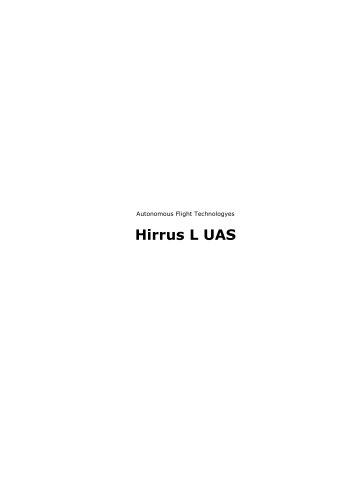
Catalog excerpts
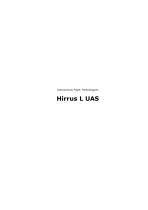
Autonomous Flight Technologyes
Open the catalog to page 1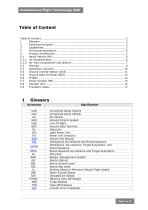
Autonomous Flight Technology R&D
Open the catalog to page 2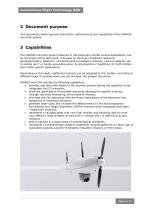
[Type text] Autonomous Flight Technology R&D 2 Document purpose This document present general description, performances and capabilities of the HIRRUS mini‐UAV system. 3 Capabilities The HIRRUS mini‐UAV system featured in this document exhibit various applications, but for the scope of this document, it focuses on the ones considered related to photogrammetry, detection, monitoring and surveillance missions, and it is ideal for use in remote and / or hardly accessible areas, during daytime or nighttime, for both military and civilian specific applications. Depending on the needs, additional...
Open the catalog to page 3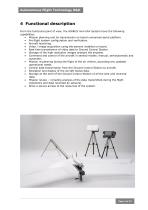
[Type text] Autonomous Flight Technology R&D 4 Functional description From the functional point of view, the HIRRUS mini‐UAV System have the following capabilities: Mission planning and its transmission on board unmanned aerial platform. Pre‐flight system configuration and verification. Aircraft launching. Video / image acquisition using the sensors installed on board. Real‐time transmission of video data to Ground Control Station. Storage of the high resolution images onboard the airplane. Command and control of the aircraft in several modes: manual, semiautomatic and...
Open the catalog to page 4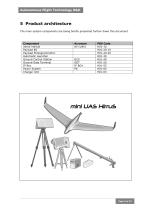
Autonomous Flight Technology R&D The main system components are being briefly presented further down this document.
Open the catalog to page 5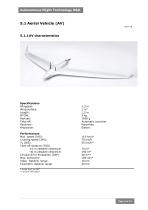
Autonomous Flight Technology R&D Automatic Launcher Parachute Electric Specifications Wingspan: Wing surface: Length: MTOW: Payload: Take-off: Recovery: Propulsion: Take-off distance (TOD) -10 m obstacle clearance: 70 m1 Circular Error Probability (CEP): 40 m2 Video Datalink range: 15 km Telemetric datalink range 20 km at zero wind speed
Open the catalog to page 6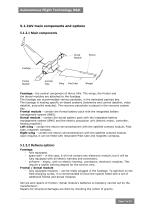
[Type text] Autonomous Flight Technology R&D 5.1.2 AV main components and options Fuselage - the central component of Hirrus UAV. The wings, the frontal and the dorsal modules are attached to the fuselage. The fuselage can accommodate various payloads, in the dedicated payload bay. The fuselage is hosting specific on-board systems (telemetry and control datalink, video datalink, auto-pilot modules). The recovery parachute is placed in the recovery system bay. Frontal module – contain the frontal battery pack with the integrated battery management system (BMS). Dorsal module – contain the...
Open the catalog to page 7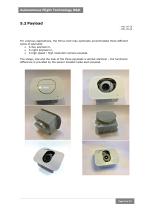
[Type text] Autonomous Flight Technology R&D For voarious applications, the Hirrus UAV may optionally accommodate three different types of payloads: A day payload or, A night payload or, A high speed / high resolution camera payload. The shape, size and the look of the three payloads is almost identical – the functional difference is provided by the sensor located inside each payload.
Open the catalog to page 8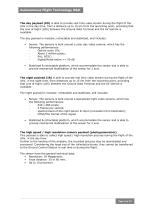
The day payload (EO) is able to provide real time video stream during the flight of the UAV in the day time, from a distance up to 15 km from the launching point, providing that the Line of Sight (LOS) between the Ground Data Terminal and the Air Vehicle is available. The day payload is modular, retractable and stabilized, and includes: • Sensor. The sensors is built around a color day video camera, which has the following performances: - Optical zoom 10x; - About 2 million pixels; - PAL, NTSC; • Stabilized & retractable platform, which accommodate the sensor and is able to provide...
Open the catalog to page 9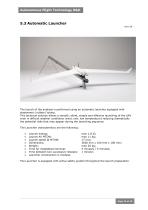
Autonomous Flight Technology R&D max 1.8 kJ; max 11 kg; 17 m/s; 3600 mm x 100 mm x 100 mm; max 20 kg; 5 minutes / 5 minutes; 1 minute; The launch of the airplane is performed using an automatic launcher equipped with elastomeric (rubber) tubing. This technical solution allows a smooth, silent, simple and effective launching of the UAV even in difficult weather conditions (wind, rain, low temperature) reducing dramatically the potential risks that may appear during the launching sequence. The Launcher characteristics are the following • Launch energy: • Launch AV MTOW: • Launch speed @...
Open the catalog to page 10
[Type text] Autonomous Flight Technology R&D 5.4 Ground Control Station (GCS) - H01-40 - Ground control station (GCS) provides: Mission planning; Mission loading onboard of UAV; Launch monitoring of UAV; Mission monitoring; Changing of the flight plan during the mission of UAV; Reception and storage of specific mission data (command, control data, video data); Offline mission play for debriefing. GCS is equipped with a self‐test system that performs automated testing at the beginning of each mission of the mini UAV, and refers malfunctions arising during the operation. The...
Open the catalog to page 11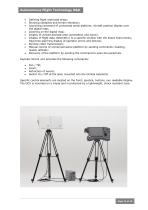
• Defining flight restricted areas; • Showing obstacles and terrain elevation; • Launching command of unmanned aerial platform; Aircraft position display over the digital map; • Zooming on the digital map; • Display of viewed payload area (orientation and zoom); • Display of flight data (telemetry) to a specific window with the board instruments; Real-time alarming display of operator errors and failures; • Remote video transmission; • Manual control of unmanned aerial platform by sending commands: heading, speed, altitude; • Recovery of the platform by sending the command to open the...
Open the catalog to page 12
[Type text] Autonomous Flight Technology R&D 5.5 Ground Data Terminal (GDT) - H01-50 - The Ground Data Terminal (GDT) provides the link between aircraft and Ground Control Station (GCS) and include the antennae management terminal. Ground Data Terminal is part of the Data Link System. The Data Link system includes the Airborne Data Terminal (located onboard the airplane) and the Ground Data Terminal (located on the ground). The Data Link System (the ground section and the airborne section) is used to support the data exchange between the Ground Control Station and the Aerial Vehicle (both...
Open the catalog to page 13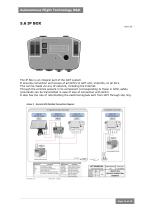
Autonomous Flight Technology R&D The IP Box is an integral part of the GDT system. It ensures connection and access of all GCS's to GDT and, implicitly, to all AV's. This can be made via any IP network, including the Internet. Through the controls present in its component (corresponding to those in GCS) safety commands can be transmitted in case of loss of connection with GCS's. It also has the role of reformatting the electrical signals sent from GDT through slip ring. Annex 3 Remote GCS Detailed Connection Diagram A. HIRRUS SYSTEM LOCATION Ground Data Terminal Ground Control Station...
Open the catalog to page 14All Autonomous Flight Technology catalogs and technical brochures
-
AUTONOMOUS
21 Pages
-
View AFT UAV systems
7 Pages
Archived catalogs
-
AFT products
4 Pages

